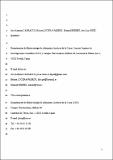Por favor, use este identificador para citar o enlazar a este item:
http://hdl.handle.net/10261/171332COMPARTIR / EXPORTAR:
 SHARE
BASE SHARE
BASE
|
|
| Visualizar otros formatos: MARC | Dublin Core | RDF | ORE | MODS | METS | DIDL | DATACITE | |

| Campo DC | Valor | Lengua/Idioma |
|---|---|---|
| dc.contributor.author | Carrasco López, José Antonio | es_ES |
| dc.contributor.author | Lucena-Padrós, Helena | es_ES |
| dc.contributor.author | Brenes Balbuena, Manuel | es_ES |
| dc.contributor.author | Ruiz-Barba, José Luis | es_ES |
| dc.date.accessioned | 2018-10-22T09:33:41Z | - |
| dc.date.available | 2018-10-22T09:33:41Z | - |
| dc.date.issued | 2018-12 | - |
| dc.identifier.citation | Food Microbiology 76: 382-389 (2018) | es_ES |
| dc.identifier.issn | 0740-0020 | - |
| dc.identifier.uri | http://hdl.handle.net/10261/171332 | - |
| dc.description | 42 Páginas; 2 Figuras; 3 Tablas; 4 Figuras suplementarias; 4 Tablas suplementarias | es_ES |
| dc.description.abstract | Genes with the potential to code for enzymes involved in phenolic compound metabolism were detected in the genome of Lactobacillus pentosus IG1, isolated from a green olive fermentation. Based on homology, these genes could code for a 6-P-β Glucosidase, two different Tannases, a Gallate decarboxylase and a p-Coumaric decarboxylase. Expression of up to seven of these genes was studied in L. pentosus IG1 (olive fermentation) and CECT4023T (corn silage), including responses upon exposure to relevant phenolic compounds and different olive extracts. Genes potentially coding Tannase, Gallate decarboxylase and p-Coumaric acid decarboxylase significatively increased their expression upon exposure to such compounds and extracts, although it was strain dependent. In general, both the genetic organization and the characteristics of gene expression resembled very much those described for Lactobacillus plantarum. In accordance to the observed induced gene expression, metabolism of specific phenolic compounds was achieved by L. pentosus. Thus, methyl gallate, gallic acid and the hydroxycinamic acids p-coumaric, caffeic and ferulic were metabolized. In addition, the amount of phenolics such as tyrosol, oleuropein, rutin and verbascoside included in a minimal culture medium was noticeably reduced, again dependent on the strain considered. | es_ES |
| dc.description.sponsorship | This research was funded by the Spanish Ministry of Economy and Competitiveness through the Project AGL2012-33400, and by the Junta de Andalucía Excellence ProjectAGR-07345. All these projects included FEDER funds. JAC was the recipient of a post-doctoral grant awarded by the Junta de Andalucía as part of the Project AGR-07345. HLP was the recipient of a contract funded by the Spanish Ministry of Economy and Competitiveness as part of the ProjectAGL2012-33400, as well as by the CSIC Project no. 201670E028. We want to express our gratitude to the table olive enterprises which have collaborated in this study: Aceitunas Los Dos S.L. (Almensilla), Olive Aljarafe S.L. (Pilas), Aceitunas Francisca Moreno S.L. (Pilas), Goya en España S.A.U. (Alcalá de Guadaira), and Jolca S.A. (Huévar). | es_ES |
| dc.language.iso | eng | es_ES |
| dc.publisher | Elsevier | es_ES |
| dc.relation | info:eu-repo/grantAgreement/MINECO/Plan Estatal de Investigación Científica y Técnica y de Innovación 2013-2016/AGL2012-33400 | es_ES |
| dc.relation.isversionof | Postprint | es_ES |
| dc.rights | openAccess | en_EN |
| dc.subject | Lactobacillus pentosus | es_ES |
| dc.subject | Tannase | es_ES |
| dc.subject | Decarboxylase | es_ES |
| dc.subject | Glucosidase | es_ES |
| dc.subject | Olive fermentation | es_ES |
| dc.subject | Phenolics | es_ES |
| dc.title | Expression of genes involved in metabolism of phenolic compounds by Lactobacillus pentosus and its relevance for table-olive fermentations | es_ES |
| dc.type | artículo | es_ES |
| dc.description.peerreviewed | Peer reviewed | es_ES |
| dc.relation.publisherversion | http://dx.doi.org/10.1016/j.fm.2018.06.020 | es_ES |
| dc.identifier.e-issn | 1095-9998 | - |
| dc.embargo.terms | 2019-12-01 | es_ES |
| dc.rights.license | http://creativecommons.org/licenses/by-nc-nd/4.0/ | - |
| dc.contributor.funder | Ministerio de Economía y Competitividad (España) | es_ES |
| dc.contributor.funder | Junta de Andalucía | es_ES |
| dc.relation.csic | Sí | es_ES |
| oprm.item.hasRevision | no ko 0 false | * |
| dc.identifier.funder | http://dx.doi.org/10.13039/501100003329 | es_ES |
| dc.identifier.funder | http://dx.doi.org/10.13039/501100011011 | es_ES |
| dc.type.coar | http://purl.org/coar/resource_type/c_6501 | es_ES |
| item.fulltext | With Fulltext | - |
| item.languageiso639-1 | en | - |
| item.openairecristype | http://purl.org/coar/resource_type/c_18cf | - |
| item.openairetype | artículo | - |
| item.cerifentitytype | Publications | - |
| item.grantfulltext | open | - |
| Aparece en las colecciones: | (IG) Artículos | |
Ficheros en este ítem:
| Fichero | Descripción | Tamaño | Formato | |
|---|---|---|---|---|
| Postprint_2018_FoodMicrobiol_V76_P382.pdf | Artículo principal | 993,56 kB | Adobe PDF |  Visualizar/Abrir |
CORE Recommender
Page view(s)
364
checked on 23-abr-2024
Download(s)
378
checked on 23-abr-2024
Google ScholarTM
Check
Este item está licenciado bajo una Licencia Creative Commons

